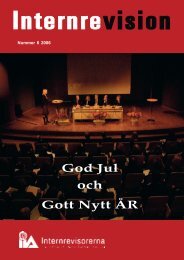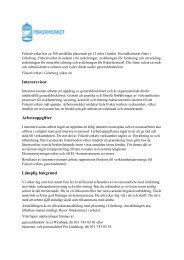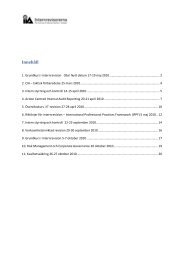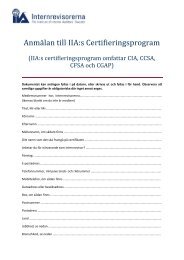#1/2011 - Internrevisorerna - Hem
#1/2011 - Internrevisorerna - Hem
#1/2011 - Internrevisorerna - Hem
You also want an ePaper? Increase the reach of your titles
YUMPU automatically turns print PDFs into web optimized ePapers that Google loves.
BLENDED<br />
ENGAGEMENTS<br />
Combining assurance and consulting services in a single audit<br />
can yield significant efficiencies for practitioners.<br />
Michael J. Head, CIA, CPA, CMA, CISA<br />
Managing Director of Corporate Audit, TD Ameritrade<br />
Kurt F. Reding, PHD, CIA, CPA, CMA<br />
Assistant Professor and Grant Thornton Faculty Fellow<br />
School of Accountancy, Wichita State University<br />
Cris Riddle, CIA, Audit Analyst II, TD Ameritrade<br />
IN TODAY’S ECONOMIC ENVIRONMENT, everyone, including<br />
internal auditors, is under pressure to do more with less. But<br />
in most cases only so much belt tightening can be done before<br />
vital organs are damaged. When costs cannot be cut any<br />
further, successful audit departments find innovative ways to<br />
stretch their resources.<br />
Blending assurance and consulting services into a single<br />
engagement is evolving as a way for internal auditors to realize<br />
efficiencies that may not exist when these services are performed<br />
separately. In fact, some internal audit functions may<br />
be conducting »blended engagements» without even realizing<br />
it. Although formal, authoritative guidance does not yet<br />
exist for performing such engagements, internal auditors can<br />
follow a principles-based model that offers professional guidance<br />
for those wishing to implement this approach without<br />
violating existing standards of practice.<br />
ASSURANCE AND CONSULTING SERVICES<br />
A first step toward formulating guidance for conducting<br />
blended engagements is to solidify internal auditors’ understanding<br />
of assurance and consulting services, which by definition<br />
comprise the two types of services audit practitio-<br />
This article was reprinted with permission from the October<br />
2010 issue of Internal Auditor, published by The Institute<br />
of Internal Auditors, Inc., www.theiia.org.<br />
ners perform. The authors define these services as follows:<br />
• Assurance services. An objective examination of evidence<br />
for the purpose of providing an independent assessment<br />
of governance, risk management, and control processes.<br />
• Consulting services. Objective advisory, facilitative, and<br />
training activities — the nature and scope of which are agreed<br />
to with the customer — intended to improve governance,<br />
risk management, and control processes.<br />
Internal auditors should keep in mind that this definition of<br />
consulting deviates somewhat from the definition provided in<br />
The IIA’s International Standards for the Professional Practice<br />
of Internal Auditing (Standards). See »Comparison<br />
to IIA Standards» at right for an analysis of the differences.<br />
As described in the Standards, assurance and consulting<br />
engagements differ in three important respects:<br />
• The primary aim of the engagement.<br />
• Who determines the nature and scope of the engagement.<br />
• The parties that are involved in the engagement.<br />
The primary purpose of an assurance engagement is to provide<br />
an independent assessment based on examination of<br />
evidence. The internal audit function determines the nature<br />
and scope of the engagement, which generally involves three<br />
parties: the party directly responsible for the process,<br />
function, system, or area being assessed (the process owner);<br />
the party providing the assessment (the internal audit<br />
function); and the party or parties who rely on the audit<br />
function’s assessment (the user(s)). Examples of assurance<br />
engagements include assessing the design adequacy and operating<br />
effectiveness of business process controls and evaluating<br />
the operational effectiveness and efficiency of a business<br />
process as reflected in performance metrics.<br />
The primary purpose of a consulting engagement is to<br />
provide independent advice, facilitation, or training services,<br />
commonly at the specific request of the engagement custo-<br />
INTERNREVISION 1/<strong>2011</strong> • 9







